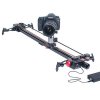Hi there,
I bought this Varavon video some one year ago together with the timeroid and the panning motoroid
http://vimeo.com/63785434
It's only now I have some friends (you know who you are) who helped me figure out how to use it ...
So, I will post here some pointers, hopefully other owners of this slider can benefit too.
Okay, firstly this connection cable is problematic, which ends you connect to on the slider matters, depending on whether the power source is INTernal or EXTernal:
[URL=http://s32.photobucket.com/user/ryan_khoo/media/IMG_9801_zpsokiq4qbm-1.jpg.html] [/URL]
[/URL]
If you wanna use the slider just to slide (WITHOUT the timeroid), then use the battery as INTernal. In this case, connect the "L end to the slider (top hole) and the other end to the battery. To move, the black button on the slider has to be switched to "1" (ie INTernal)
But if you wanna use the slider to slide WITH the timerroid so that you can do stop-shoot-move motion for long exposure timelapse, then this time, connect the NON - "L" end to the slider but unlike the earlier case, this time connect the lower hole for EXTernal connection. Then, the "L" end goes to the timerroid (motor 1 - motor 1 is the hole nearer to the edge). To activate, the black button must be switched to "O" (ie EXTernal)
The cable ends of the cable release also matters, The bigger "L" end goes to the camera while the other end goes to the timerroid. If an extension cable is used for the cable release bcos the original cable release is not long enuf to move the entire 1 metre of the slider, then there will be two "L" ends. One bigger "L" and one smaller "L". The bigger "L" goes to the camera remote slot while the smaller "L" goes to the timerroid.
okay, other pics for illustration:
direct connection from slider to battery - INT. The "L" end connects to the slider thru the top hole - for INT connection. To activate, black button switch to "1" (ie internal soucre)
[URL=http://s32.photobucket.com/user/ryan_khoo/media/IMG_9794_zpsaqekttts-1.jpg.html] [/URL]
[/URL]
I bought this Varavon video some one year ago together with the timeroid and the panning motoroid
http://vimeo.com/63785434
It's only now I have some friends (you know who you are) who helped me figure out how to use it ...
So, I will post here some pointers, hopefully other owners of this slider can benefit too.
Okay, firstly this connection cable is problematic, which ends you connect to on the slider matters, depending on whether the power source is INTernal or EXTernal:
[URL=http://s32.photobucket.com/user/ryan_khoo/media/IMG_9801_zpsokiq4qbm-1.jpg.html]
 [/URL]
[/URL]If you wanna use the slider just to slide (WITHOUT the timeroid), then use the battery as INTernal. In this case, connect the "L end to the slider (top hole) and the other end to the battery. To move, the black button on the slider has to be switched to "1" (ie INTernal)
But if you wanna use the slider to slide WITH the timerroid so that you can do stop-shoot-move motion for long exposure timelapse, then this time, connect the NON - "L" end to the slider but unlike the earlier case, this time connect the lower hole for EXTernal connection. Then, the "L" end goes to the timerroid (motor 1 - motor 1 is the hole nearer to the edge). To activate, the black button must be switched to "O" (ie EXTernal)
The cable ends of the cable release also matters, The bigger "L" end goes to the camera while the other end goes to the timerroid. If an extension cable is used for the cable release bcos the original cable release is not long enuf to move the entire 1 metre of the slider, then there will be two "L" ends. One bigger "L" and one smaller "L". The bigger "L" goes to the camera remote slot while the smaller "L" goes to the timerroid.
okay, other pics for illustration:
direct connection from slider to battery - INT. The "L" end connects to the slider thru the top hole - for INT connection. To activate, black button switch to "1" (ie internal soucre)
[URL=http://s32.photobucket.com/user/ryan_khoo/media/IMG_9794_zpsaqekttts-1.jpg.html]
 [/URL]
[/URL]
Last edited:
















